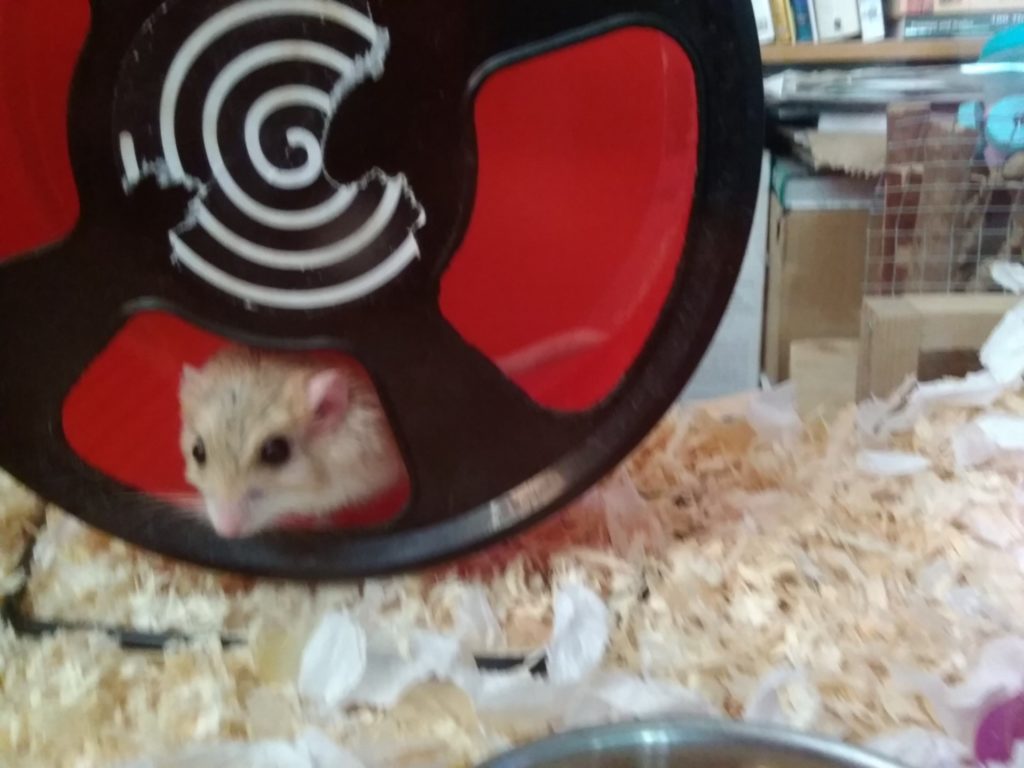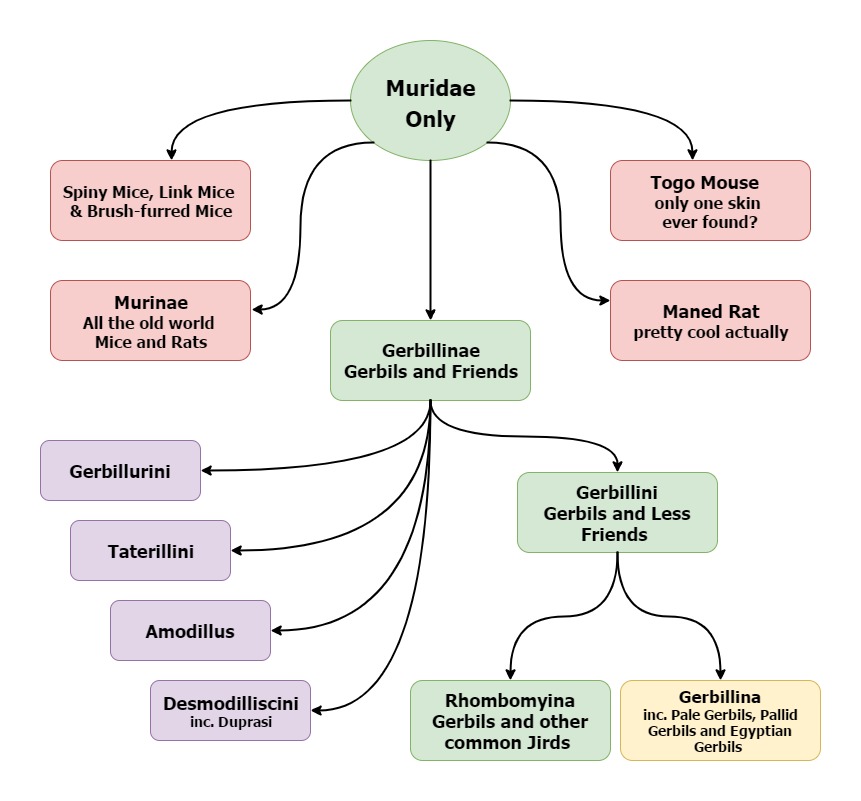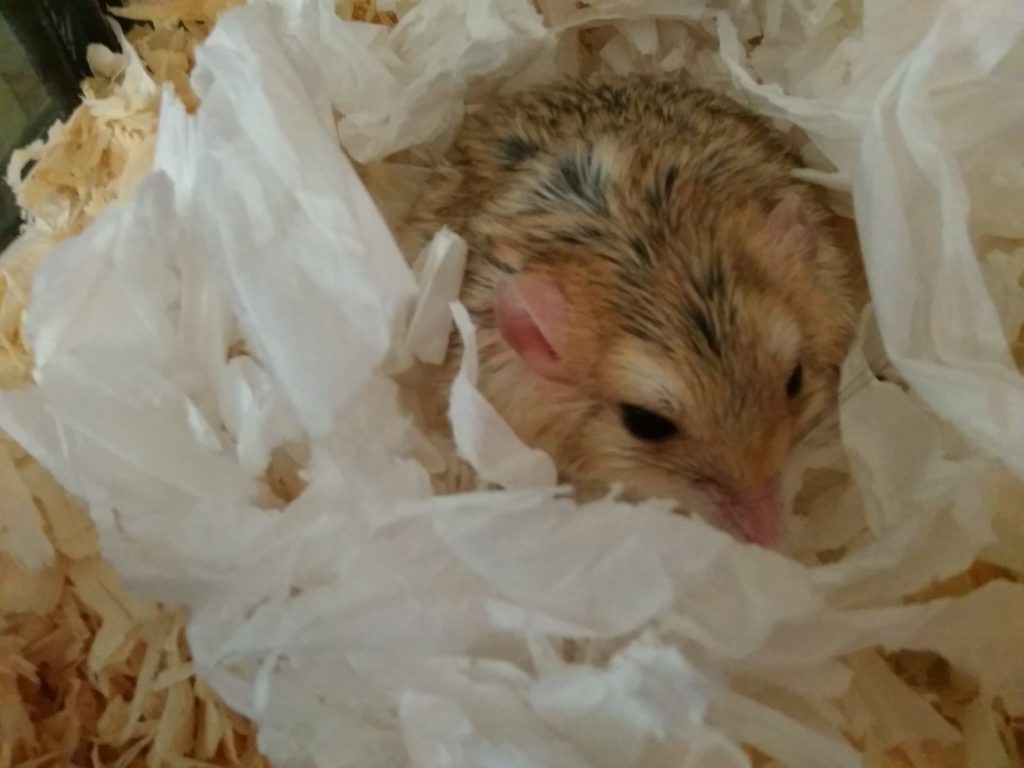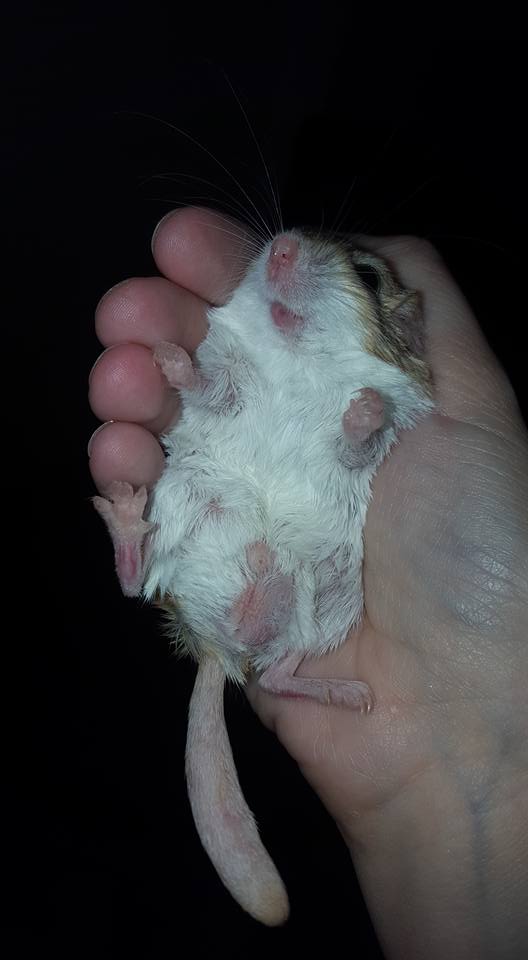Well, finally, we are in a position to get ourselves some doops.
We have looked after one for someone before and fell in love – she was called Christie (born at Christmas if you didn’t guess how she got her name) and she was adorable. Totally.
And her wheel (below) was her most favourite thing.

So we are starting this diary so we can share how it all goes, what we do, what we don’t do – and why. It also documents a bit about their care and companionship and a bit about their life history as a species and as a pet. We may even attend a few shows?
Anyway, for now – here is a bit of background into duprasis – or fat tailed gerbils and a few pictures!
Duprasi Fact 1: Duprasi Genetics
Duprasis are in a genetic group on their own (Desmodilliscini) and of the genus Pachyuromys (Pachyuromys duprasi to be precise) – and are not as closely related to other gerbils as their common name might suggest.
All the other well-known gerbils and jirds (shown in green on the below diagram) – including the Mongolian Gerbil, the Shaw’s Jird and the Persian Jird are all in the group Rhombomyina.

They aren’t so different in overall appearance though – just much more flat-looking.
Duprasi Fact 2: Duprasi Are Like Hamsters
They are almost like a Syrian hamster in character rather than a gerbil.
They are not obsessed with deep digging and chewing cardboard and wooden houses half as much as gerbil do – so no need for a really deep tank for them or a constant supply of cardboard from your friends.
They tend to walk around on the surface of the bedding and maybe scuffle around in the top layer – so need a spacious and wide/long tank with at least 2 inches of soft bedding. They do like enrichment though, so platforms, bridges and ledges will all be well investigated as well as branches and hay to chew on.
And they sleep, like, a lot? And really heavily. Often upside-down.

They aren’t great climbers either (well they can go up really well – just haven’t quite mastered the elegant coming-back-down) so watch out for anything higher than their house as they often fall off things – not the smartest of cookies as you will find out.
Duprasi Fact 3: Duprasi Have Fat Tails
Duprasi have a fat tail (hence their common name of fat-tailed gerbil).
This fattened tail acts like an energy reserve – sort of like a camel’s hump if you like. A healthy duprasi will have a well formed chunky little tail (see image below) as opposed to a shrivelled-looking damaged one. These tails have adorable ginger hairs on them when you look closely. So smooth too.
Living in desert-like conditions – they have adapted to the harsh environment in a different way to other fast-moving gerbils – they focus on slow and steady – and so prefer to carry around their food supplies rather than run around every day looking for it.

Duprasi Fact 4: Duprasi Can ‘Pancake’
They are also called ‘beer mat’ gerbils due to their rather flattened appearance when stationary.
They sort of mould themselves out flat like a pancake – like gravity takes over and spreads them out sideways?
And as they aren’t fast moving, you could be mistaken into thinking that they have been run over or were infact a lovely beer mat!
Duprasi Fact 5: Duprasi Don’t Live In Groups
Duprasis tend to live best alone – and many of the females certainly prefer it that way – however couples of either sex can get along for varying periods of time.
Again this is half-way between gerbils and Syrian hamsters, where gerbils love companions, but can still squabble or fight with a particular friend. Best to just offer the biggest and most enrichment-filled enclosure with two of everything and you make everything better for them.
Putting a male and female duprasi together can be easy, but getting her to like him can certainly be a lifelong struggle. We have heard of females living their entire life alone after beating up every male she ever met. However, we have had couples living together happily for their entire lives (but not producing any pups – as otherwise we would have to split them).
So, breeding-wise – beware that some females just never accept a mate. They just barely tolerate them (just like some humans we know?).
Duprasi Fact 6: Duprasi Are Quite Unusual Pets
Finding two unrelated and healthy duprasis to match up for a breeding couple isn’t easy.
When a species is relatively new to the pet trade, there is always the worry that if you don’t keep on top of your record keeping, that two individuals you find at different ends of the country may well be litter mates – not as distantly related as you had hoped. Duprasi get couriered all over the country at the drop of a hat!
So, to keep your own stock healthy and strong – do always check the history of a new doop you are interested in, and keep your own records well for any future pups you want to pass on.
If you are going to be one of the first breeders of something and introduce them to a new area – you don’t want to be the one making them inbred already do you?
Duprasi Final Fact: Do Duprasi Live Up To 8 Years?
The most important one to know before getting your own doops: they can apparently live up to 8 years in captivity. Well, so all the old reports tell us?
They may not be like all other pocket pets you might have heard of that are only with us for a few years max. Unlike Mongolian gerbils and Syrian hamsters – which they are so much like visually and behaviourally – these little ones can apparently hang around a bit longer. Anything from 5 years onwards – which for us is a good thing – although most reports currently (2020) seems to be around the 3 mark (?).
I always find it sad when my little critters go so soon, so being told that these sleepy-heads could be around for double or even treble the time – makes them much more of an investment…
Maybe it has something to do with all that sleeping?
I have a male Doop – he is 2 1/2 but is losing weight. I took him to the vet – he was put on anti biotics which helped for a while – but now is again not interested in food – I bought some vitamin drops and put in his water but as he doesn’t drink much I now give him the solution from the bottle via a tiny syringe – just a couple of drops a day. This is really helping.
He is a lovely little chap and very responsive.
Ahh, the poopr little tyke. did the vet say what the thought it could be that was causing his symptoms?
Glad he is responding well to your extra efforts there with the hand feeding. What sort of food are you feeding as a change around in this and the layout of his enclosure may well help to control or even reverse the weight loss. Perhaps have a look at the articles I have on here for Mongolian gerbils for older or sick gerbils – as reducing ‘stress’ and increasing access to certain foods can sometimes make a real difference.
Let us know how he gets on…
RodentZone